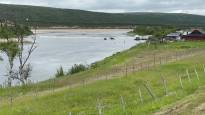According to the Norwegian Environment Agency, the dam is being dismantled because only a few humpback salmon have been caught recently. In fact, the dam has not worked all summer, but a hundred thousand humpback salmon have entered Teno.
The Norwegian Environment Agency is dismantling the humpback dam, which was built in June on the lower reaches of Tenojoki on the Norwegian side. The agency reported about it yesterday on the messaging service X (formerly Twitter). The dam was supposed to divert humpback salmon into a trap from which they would have been removed.
According to the Norwegian Environment Agency, less than 8,000 humpback salmon have been removed from Teno. The amount is modest.
Luke’s researcher at the Finnish Center for Natural Resources Panu Orell recently estimated that a hundred thousand humpback salmon have already landed in Teno and the number could be up to 140,000 by September.
The dam favored humpback salmon but hindered Atlantic salmon
The aim is to remove humpback salmon, because it is an alien species that is estimated to hinder the life of the original Atlantic salmon populations in the Tenojoki watershed.
The Norwegian humpback dam has been criticized both on the Norwegian and Finnish sides of Tenojoki.
According to the review, the dam allowed humpback salmon into the river but prevented the spawning of the original Atlantic salmon populations of Teno and its tributaries.
Local residents who have lived with Tenojoki salmon for generations and also Finnish fish scientists doubted the functionality of the dam planned by the Norwegian authorities in the large and wide Tenojoki. In the small salmon rivers on the Norwegian side, weir fishing and seining have been much more successful.
Now in August, it seems that the doubters and critics have been right, at least as far as humpback salmon is concerned.
According to Luke’s researcher Panu Orelli, based on sonar monitoring, it seems that the rise of Atlantic salmon will remain weak this summer as well. The possible contribution of the Kyttyrälo dam to the matter is unknown and, according to Orelli, it is difficult to find out afterwards.
